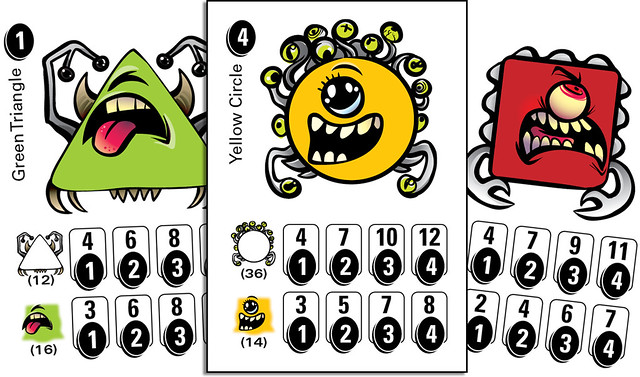 A long time ago, I designed a tile-swapping game featuring little cyclops creatures drawn by Kari Fry. I wasn't entirely satisfied with how that game turned out, so it's lingered in my mind for some time. Here is my current thought on how it would be implemented as a simple euro-style card trading game.
A long time ago, I designed a tile-swapping game featuring little cyclops creatures drawn by Kari Fry. I wasn't entirely satisfied with how that game turned out, so it's lingered in my mind for some time. Here is my current thought on how it would be implemented as a simple euro-style card trading game.You'll notice these mechanics from my previous post "Make Me An Offer," which adapted Apples to Apples mechanics into a straight strategy game. The card values are based on the beans in the classic game Bohnanza. Hopefully combining the two with a dash of something original makes a satisfying game. You tell me!
Click the link below for the print-and-play prototype. I literally whipped this up in an hour, so there are some rough areas. Specifically, the cards need a miniature suit icon on the top corners for ease of reference. Ah well, such is the life in rapid iteration. :)
» Print-and-Play Cards
SETUP
Shuffle all the cards and deal five to each player. Set the remaining cards as a draw deck and set aside space for discarded cards. Also set aside space for each player to have three stacks of cards, called "sets." Finally, gather a general supply of chips representing points.
 |
| Example Setup for Two Player Game |
ON YOUR TURN...
STEP 1: Place one or two cards from your hand into one of your sets. These cards must share a shape or a color in common. Once you have established that common trait, no other cards can be added to that set unless they also share that trait in common.
 |
| Example Step 1: Collect. You add two reds to your collection. From now on, only red cards can be added to this set. |
STEP 2: Reveal the top card from the draw deck. Your opponent may reveal one or two cards from her hand. Place these revealed cards in the middle of the table. You are being offered these cards.
 |
| Example Step 2: Offering. A red square is revealed from the deck. Your opponent offers a blue circle and a tan circle. |
STEP 3: You may accept one or two of the offered cards and place them directly into one or two of your sets. If you have no room in your sets for one of your accepted cards, you must SCORE one of your sets for gold coins to make room. (See STEP 5 for details.) Any unaccepted cards go into the discard pile. If you accept a card offered by an opponent, they earn the points noted at the top left of that card.
STEP 4: Draw up cards into your hand until you have a full hand of five cards.
 |
| Example Step 4: Drawing Up. You draw two more cards to fill your hand back up to five. |
SCORE: At the end of your turn, you may score one or more sets. When you score a set, the chart at the bottom of the cards tells you how many points you can earn. You score points for the common trait of the whole set. So, if your set shares a shape in common, you only score points for the shapes, not the colors. (The small parenthetical numbers show how frequently that trait appears in the deck.) Once you have scored a set, discard those cards. You now have a free space to start a new set.
ENDGAME: When you've gone through the deck, once (for two players), twice (for three players) or three times (for four players), the game is over. The player with the most points wins!


No comments:
Post a Comment